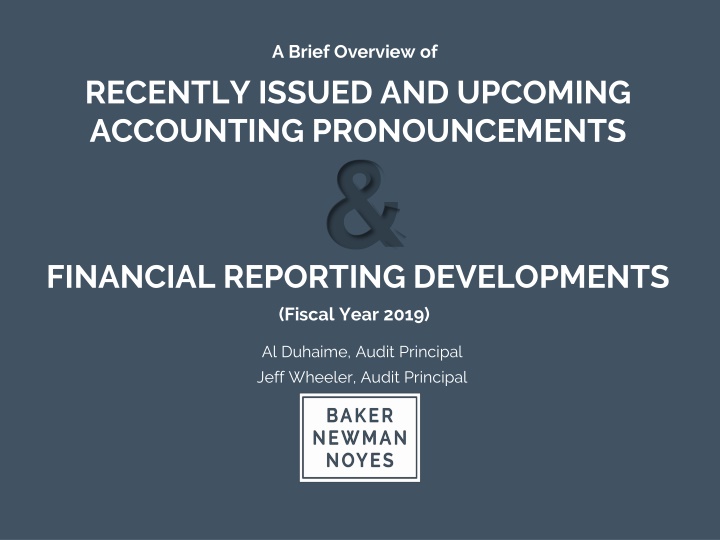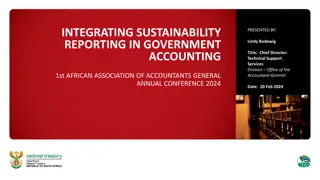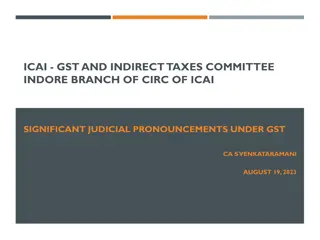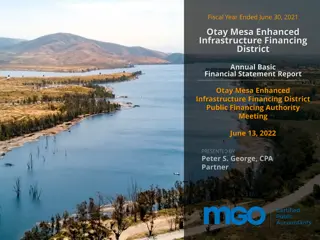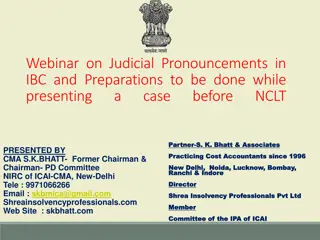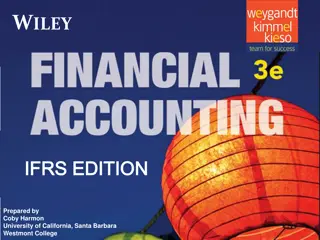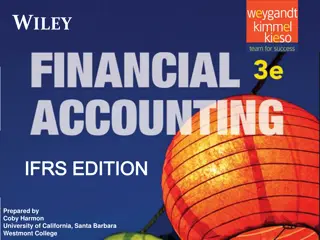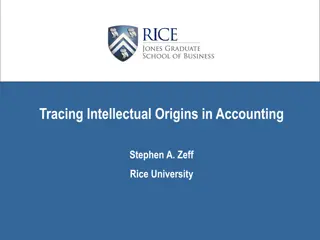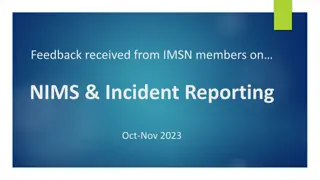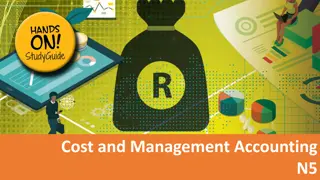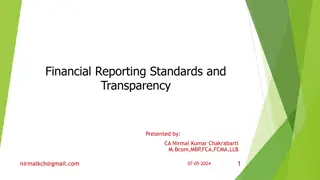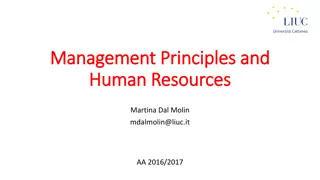Recent Accounting Pronouncements & Financial Reporting Developments
Providing an overview of new and upcoming accounting pronouncements and financial reporting developments for fiscal year 2019. The presentation covers changes impacting businesses, best practices for preparation, and potential future accounting changes under discussion.
Download Presentation

Please find below an Image/Link to download the presentation.
The content on the website is provided AS IS for your information and personal use only. It may not be sold, licensed, or shared on other websites without obtaining consent from the author.If you encounter any issues during the download, it is possible that the publisher has removed the file from their server.
You are allowed to download the files provided on this website for personal or commercial use, subject to the condition that they are used lawfully. All files are the property of their respective owners.
The content on the website is provided AS IS for your information and personal use only. It may not be sold, licensed, or shared on other websites without obtaining consent from the author.
E N D
Presentation Transcript
A Brief Overview of RECENTLY ISSUED AND UPCOMING ACCOUNTING PRONOUNCEMENTS & FINANCIAL REPORTING DEVELOPMENTS (Fiscal Year 2019) Al Duhaime, Audit Principal Jeff Wheeler, Audit Principal
TODAYS PRESENTERS ALAN DUHAIME Audit Principal 603.626.2240 aduhaime@bnncpa.com JEFF WHEELER Audit Principal 603.626.2215 jwheeler@bnncpa.com MAINE | MASSACHUSETTS | NEW HAMPSHIRE
TODAYS OBJECTIVES Provide Give Talk a brief overview of new and upcoming accounting and reporting pronouncements that have been issued that will be effective in years subsequent to 2019. you with an update on accounting and reporting changes impacting you for 2019, and share best practices to prepare, plan, and implement. a bit about potential accounting and reporting changes that are in discussion phases / comment phase. MAINE | MASSACHUSETTS | NEW HAMPSHIRE
TODAYS AGENDA Topic Time (minutes) Introduction 5 Revenue from Contracts with Customers 15 Lease Accounting Changes 10 Other Accounting Changes 15 Other Auditing and Regulatory Developments 15 Questions 10 MAINE | MASSACHUSETTS | NEW HAMPSHIRE
OTHER 2019 CALENDAR YEAR-END UPDATES NONPUBLIC ENTITIES Statement of Cash Flows (Topic 230): Classification of Certain Cash Receipts and Cash Payments - These amendments provide cash flow statement classification guidance for: 1. Debt Prepayment or Debt Extinguishment Costs; 2. Settlement of Zero-Coupon Debt Instruments or Other Debt Instruments with Coupon Interest Rates That Are Insignificant in Relation to the Effective Interest Rate of the Borrowing; 3. Contingent Consideration Payments Made after a Business Combination; 4. Proceeds from the Settlement of Insurance Claims; 5. Proceeds from the Settlement of Corporate-Owned Life Insurance Policies, including Bank-Owned Life Insurance Policies; 6. Distributions Received from Equity Method Investees; 7. Beneficial Interests in Securitization Transactions; and 8. Separately Identifiable Cash Flows and Application of the Predominance Principle. ASU 2016-15 Statement of Cash Flows (Topic 230): Restricted Cash - These amendments require that a statement of cash flows explain the change during the period in the total of cash, cash equivalents, and amounts generally described as restricted cash or restricted cash equivalents. As a result, amounts generally described as restricted cash and restricted cash equivalents should be included with cash and cash equivalents when reconciling the beginning-of- period and end-of-period total amounts shown on the statement of cash flows. The amendments do not provide a definition of restricted cash or restricted cash equivalents. ASU 2016-18 MAINE | MASSACHUSETTS | NEW HAMPSHIRE
OTHER 2019 CALENDAR YEAR-END UPDATES NONPUBLIC ENTITIES Business Combinations (Topic 805): Clarifying the Definition of a Business - These amendments clarify the definition of a business. The amendments affect all companies and other reporting organizations that must determine whether they have acquired or sold a business. ASU 2017-01 The definition of a business affects many areas of accounting including acquisitions, disposals, goodwill, and consolidation. The amendments are intended to help companies and other organizations evaluate whether transactions should be accounted for as acquisitions (or disposals) of assets or businesses. Compensation Retirement Benefits (Topic 715): Improving the Presentation of Net Periodic Pension Cost and Net Periodic Postretirement Benefit Cost - The amendments apply to all entities that offer employees defined benefit pension plans, other postretirement benefit plans, or other types of benefits accounted for under Topic 715, Compensation Retirement Benefits. The amendments require that an employer report the service cost component in the same line item or items as other compensation costs arising from services rendered by the pertinent employees during the period. The other components of net benefit cost are required to be presented in the income statement separately from the service cost component and outside a subtotal of income from operations, if one is presented. If a separate line item or items are used to present the other components of net benefit cost, that line item or items must be appropriately described. If a separate line item or items are not used, the line item or items used in the income statement to present the other components of net benefit cost must be disclosed. ASU 2017-07 The amendments also allow only the service cost component to be eligible for capitalization when applicable (e.g., as a cost of internally manufactured inventory or a self-constructed asset). MAINE | MASSACHUSETTS | NEW HAMPSHIRE
STEPS TO TAKE IN THIS CHANGING ENVIRONMENT Identify responsible parties to oversee implementation of these complex pronouncements Set appropriate goals, timetables, accountability, and track progress towards implementation Evaluate IT Systems and resources to ensure they meet the requirements to capture, track, summarize, and report the data needed to account and report under these standards Involve external advisors and professionals early Have good up-front communication with lenders and other users of your financial statements MAINE | MASSACHUSETTS | NEW HAMPSHIRE
REVENUE FROM CONTRACTS WITH CUSTOMERS (TOPIC 606) Effective for non-public fiscal years beginning after December 15, 2018 (calendar 2019) The core premise is that an entity should recognize the amount of revenue it expects to be entitled to for the transfer of promised goods or services to customers. Step 5 Recognize revenue when (or as) the entity satisfies a performance obligation. Step 4 Allocate the transaction price to the performance obligations in the contract. Step 3 Determine the transaction price. Step 2 Identify the performance obligations in the contract. Step 1 Identify the contract(s) with a customer. MAINE | MASSACHUSETTS | NEW HAMPSHIRE
LESSONS LEARNED FROM PUBLIC COMPANIES Full Retrospective for 2 years of presentation Negative effects and more deferred revenue / less equity Confusion over correction of an error versus adoption of a new accounting pronouncement Presentation Changes due to Principal vs Agent consideration (revenues now reported net of fees to drivers, versus gross with related driver expense under old rules) Market reacted negatively at first given top line reduction Positive impact - Used the modified retrospective adoption approach Reduced accumulated deficit and accelerated earnings for certain lease arrangements (now sales with a right of return vs a lease) Tesla Uber General Electric MAINE | MASSACHUSETTS | NEW HAMPSHIRE
REVENUE RECOGNITION - WHAT SHOULD YOU BE DOING NOW Ensure records and files containing customer contracts and specifics on terms of product and service sales are accurate and complete Review standard contracts to fully understand the nuances of your product and service deliverables Consider the impact of other items impacted by the new pronouncement, such as contract acquisition costs, setup costs, fulfillment, and sales commissions Decide on an adoption approach MAINE | MASSACHUSETTS | NEW HAMPSHIRE
REVENUE RECOGNITION FROM RULES BASED TO PRINCIPLES BASED Old rules were very specific, and industry focused New rules are principles based, and require more evaluation, judgement, and estimation oExamples include contract duration (especially with termination provisions), renewals, variable consideration provisions, and allocation of transaction price to each performance obligation based on stand-alone selling prices MAINE | MASSACHUSETTS | NEW HAMPSHIRE
STEP ONE: IDENTIFY CONTRACT(S) A contract is defined in ASC 606 as an agreement between two or more parties that creates enforceable rights and obligations Enforceability of rights and obligations in a contract is a matter of law Contracts can be written, oral or implied by an entity s customary business practices Practices and processes for establishing contracts may vary within a business Companies have to consider processes and practices when determining whether an agreement creates enforceable rights and obligations MAINE | MASSACHUSETTS | NEW HAMPSHIRE
STEP ONE: IDENTIFY CONTRACT(S) Arrangement must meet all these criteria to be a contract further evaluated for revenue recognition under the overall model in ASC 606: Parties have approved the contract and are committed to perform The Company can identify each party s rights regarding the goods or services to be transferred The contract s payment terms can be identified Contract has commercial substance It is probable that the Company will collect substantially all of the consideration to which it will be entitled in exchange for the goods or services that will be transferred to the customer. In evaluating whether collectability is probable, an entity shall consider only the customer s ability and intention to pay that amount when it is due MAINE | MASSACHUSETTS | NEW HAMPSHIRE
STEP TWO: IDENTIFY THE PERFORMANCE OBLIGATIONS IN THE CONTRACT Definition of performance obligation At contract inception, an entity shall assess the goods or services promised in a contract with a customer and shall identify as a performance obligation each promise to transfer to the customer either: a. A good or service (or a bundle of goods or services) that is distinct b. A series of distinct goods or services that are substantially the same and that have the same pattern of transfer to the customer. MAINE | MASSACHUSETTS | NEW HAMPSHIRE
STEP TWO: TWO DISTINCT CRITERIA Are promised goods or services distinct from other goods and services in the contract? To be distinct, a promised good or service must meet the following two criteria: 1. It must be capable of being distinct 2. It must be separable from other promises in the contract a) Is the contract to deliver multiple promised goods or services or b) a combined item(s) that comprises the individual goods or services promised in the contract (may require significant judgement) MAINE | MASSACHUSETTS | NEW HAMPSHIRE
STEP THREE: DETERMINE THE TRANSACTION PRICE Transaction price is the amount of consideration a party in the contract expects to be entitled to Be on the lookout for: oVariable consideration oNon-cash consideration oConsideration payable to the customer (for example coupons, vouchers) that can be applied against amounts owed oLoyalty or Rewards Programs oVolume discounts A contract s enforceable rights and obligations at inception influence whether it includes customer options or variable consideration MAINE | MASSACHUSETTS | NEW HAMPSHIRE
STEP FOUR: ALLOCATE THE TRANSACTION PRICE TO THE PERFORMANCE OBLIGATIONS IN THE CONTRACT Allocate the transaction price to each performance obligation on the basis of its stand-alone selling price Allocate discounts proportionally to all performance obligations MAINE | MASSACHUSETTS | NEW HAMPSHIRE
STEP FIVE: RECOGNIZE REVENUE WHEN (OR AS) THE ENTITY SATISFIES A PERFORMANCE OBLIGATION A performance obligation is satisfied when a customer obtains control of the good or service oControl is the ability to direct the use of, and obtain substantially all of the remaining benefits from the asset oControl can transfer over time, or at a point in time MAINE | MASSACHUSETTS | NEW HAMPSHIRE
RECOGNITION OF REVENUE AND TRACKING PROGRESS Measuring Progress use a method that best depicts the transfer of goods or services (output and input methods) oIf unable to reasonably recognize progress, recognize revenues to the extent of costs incurred A change from prior rules for industries like construction, completed contract method is no longer allowed Indicators that control has transferred oYou have a present right to payment oCustomer has taken legal title to an asset oPhysical possession of an asset has transferred oCustomer has significant risks and rewards of ownership oCustomer has accepted the asset (however acceptance clauses may be an informality) oIf you sell with trial / evaluation periods, control does not transfer until customer acceptance MAINE | MASSACHUSETTS | NEW HAMPSHIRE
REVENUE RECOGNITION THINGS TO WATCH OUT FOR Contract modifications Warranties (could be a separate performance obligation or cost accrual) Rights of return (not a separate performance obligation, but gives rise to variable consideration, and requires recognition of estimated refund liabilities and assets for expected product returns upon sale) Costs to obtain a contract (old GAAP, expensed as incurred ; new rules recognize as an asset if you are expected to recover them) MAINE | MASSACHUSETTS | NEW HAMPSHIRE
TOPIC 606 - METHODS OF ADOPTION Full Retrospective Method Retrospectively to each prior reporting period presented There are short-cut practical expedients Modified Retrospective Method Retrospectively with the cumulative effect recognized at the date of initial application Additional disclosure required to address comparability MAINE | MASSACHUSETTS | NEW HAMPSHIRE
TOPIC 842 - LEASE ACCOUNTING CHANGE New Lease Accounting Standards Effective for non-public fiscal years beginning after December 15, 2019 (calendar 2020; HOWEVER, will most likely be delayed to 2021) Requires almost all leases to be recorded on the balance sheet (with a liability for the obligation ; and a right to use asset on your balance sheet) ; income statement differences (effective interest method vs straight line expense) Modified retrospective transition approach MAINE | MASSACHUSETTS | NEW HAMPSHIRE
LEASE ACCOUNTING KEY CHANGES Moves the measurement and disclosure of operating leases from the footnotes of GAAP Financial Statements to the balance sheet as assets and liabilities. Now two lease types: 1. Finance Similar to capital leases 2. Operating Similar to the prior concept of operating leases MAINE | MASSACHUSETTS | NEW HAMPSHIRE
LEASES WHAT TO BE DOING NOW Gather key documents and extract data Look for embedded leases in nonlease contracts, and evaluate practical expedients to make the transition easier Evaluate whether new lease accounting software is necessary and worthwhile MAINE | MASSACHUSETTS | NEW HAMPSHIRE
LEASES PREPARE FOR: Changes to systems and internal controls, tracking and standard accounting entries Changes to debt covenants and the potential need to modify existing debt arrangements: May have material impacts on EBITDA Measures, bonus arrangements and calculations, financial ratios MAINE | MASSACHUSETTS | NEW HAMPSHIRE
KEY CONCEPTS - LEASING The Contract conveys the right to control and direct the use of the asset Need a legally enforceable contract between two+ parties Contract fulfillment depends on the use of an identified asset MAINE | MASSACHUSETTS | NEW HAMPSHIRE
ACCOUNTING FOR THE LEASE Recognition of long-term leases as assets and liabilities oLease payment liability oRight to use asset oMeasurements include (if reasonably certain) Options to extend Options to purchase oOperating leases cash payments as operating activities oFinance Leases cash payments as financing activities oInitial direct costs are included in the lease payments and capitalized oDiscount rates can be: Rate implicit in the lease unless the rate cannot be easily determined or An incremental borrowing rate or Private companies can make an accounting policy election to use a risk-free discount rate for the lease MAINE | MASSACHUSETTS | NEW HAMPSHIRE
SHORT-TERM LEASES Lessees can make a measurement exception accounting policy election for short-term leases with a term of 12 months or less that does not contain an option to purchase the underlying asset that the lessee is reasonably certain to exercise. MAINE | MASSACHUSETTS | NEW HAMPSHIRE
ASU 2016-18: CASH FLOWS AND RESTRICTED CASH These amendments require that a statement of cash flows explain the change during the period in the total of cash, cash equivalents, and amounts generally described as restricted cash or restricted cash equivalents. As a result, amounts generally described as restricted cash and restricted cash equivalents should be included with cash and cash equivalents when reconciling the beginning-of-period and end-of-period total amounts shown on the statement of cash flows. The amendments do not provide a definition of restricted cash or restricted cash equivalents. MAINE | MASSACHUSETTS | NEW HAMPSHIRE
FINANCIAL INSTRUMENTS RECOGNITION AND MEASUREMENT The amendments change disclosure requirements, and requires among other things: Requires equity investments (except those accounted for under the equity method of accounting, or those that result in consolidation of the investee) to be measured at fair value with changes in fair value recognized in net income. Requires public business entities to use the exit price notion when measuring the fair value of financial instruments for disclosure purposes. Eliminates the requirement for public business entities to disclose the method(s) and significant assumptions used to estimate the fair value that is required to be disclosed for financial instruments measured at amortized cost. Requires separate presentation of financial assets and financial liabilities by measurement category and form of financial asset (i.e., securities or loans and receivables). MAINE | MASSACHUSETTS | NEW HAMPSHIRE
DEFINED BENEFIT PLANSCHANGES TO DISCLOSURE REQUIREMENTS Improve the effectiveness of pension note disclosures for sponsors of defined benefit pension plans, and removes the requirements to: Related party disclosures about the amount of future annual benefits covered by insurance and annuity contracts and significant transactions between the employer or related parties to the plan Disclose the amounts in accumulated other comprehensive income expected to be recognized as components of net periodic cost over the fiscal year The amount and timing of plan assets expected to be returned to the employer Level 3 investment reconciliations (but keeps transfer disclosure requirements) Sensitivity analysis disclosures (public companies) MAINE | MASSACHUSETTS | NEW HAMPSHIRE
DEFINED BENEFIT PLANSCHANGES TO DISCLOSURE REQUIREMENTS Adds requirements to disclose: The weighted-average interest crediting rates for cash balance plans and other plans with promised interest credit rates An explanation of any other significant changes in the benefit obligation or plan assets that are not otherwise apparent in other disclosures An explanation of the reasons for significant gains/losses related to changes in the benefit obligation for the period MAINE | MASSACHUSETTS | NEW HAMPSHIRE
OTHERFUTURE ITEMS TO BE AWARE OF Derivatives and Hedging Targeted Improvements to Accounting for Hedging Activities Stock Compensation to Nonemployees (will align with options to employees) Revenue Updates, Technical corrections, and improvements Goodwill Impairment Test Simplification Financial Instruments Credit Losses MAINE | MASSACHUSETTS | NEW HAMPSHIRE
REGULATORY - SALES TAXES AND THE WAYFAIR DECISION For many years, the Quill decision limited states ability to tax sales made to customers in their states by out-of-state companies. In 2018, the US Supreme Court eliminated the physical presence requirement for states to require businesses to collect and remit state sales tax, and established economic nexus as the sales tax nexus standard. This means there is a responsibility for businesses to collect and remit sales taxes properly and in accordance with state and local jurisdiction laws (10,000 different jurisdictions in the U.S. each with different rates, rules, and regulations). MAINE | MASSACHUSETTS | NEW HAMPSHIRE
SALES TAX EXPOSURES STEPS TO TAKE Identify sales and number of transactions by state, by year Perform an analysis or engage a professional to evaluate products and services and taxability under various state and local laws Add internal controls and collection requirements in jurisdictions where you have a responsibility to collect and remit taxes MAINE | MASSACHUSETTS | NEW HAMPSHIRE
OTHER AUDITING AND REPORTING Look for New Reporting Requirements by Auditors of Critical Audit Matters(CAMs) or Key Audit Matters (KAMs) New Auditor Reporting Standards and Opinion MAINE | MASSACHUSETTS | NEW HAMPSHIRE
ABOUT US More than 250 employees Strong reputation in our markets as a trusted business advisor Ranked in Accounting Today and INSIDE Public Accounting s lists of the top 100 firms in the U.S Named one of the top 10 accounting firms in Boston by AdvisoryHQ Our banking practice works with financial institutions across New England and beyond, including commercial and savings banks, community banks, SEC registered banks, credit unions, trust companies, non-depository trust companies and registered investment advisors. Four offices located in Maine, Massachusetts, and New Hampshire Through our membership in Baker Tilly International, a network of independent accounting and advisory firms, we have access to global resources with a seamless service approach delivered by a BNN lead principal MAINE | MASSACHUSETTS | NEW HAMPSHIRE
KEY INDUSTRIES Banking & Financial Services Construction Craft Beverage Family-Owned Businesses Governmental Agencies Healthcare Manufacturing, Retail & Distribution Not-for-profit & Foundations Professional Services Real Estate MAINE | MASSACHUSETTS | NEW HAMPSHIRE
ASSURANCE SERVICES Accurate, reliable, and independent. Our assurance practice is founded on these three principles. We build on this foundation with a collaborative, proactive approach that helps you solve problems and maximize opportunities. Baker Newman Noyes professionals are specialists with focused skills and experience ready to assist clients with the latest industry knowledge and techniques. Our assurance practice offers a wide range of services to clients, such as: Agreed upon procedures Employee benefit plan audits Financial statement audits, reviews, and compilations Forensic accounting Internal audit and accounting assistance Merger and acquisition consulting Prospective financial statements Testing of internal controls and other compliance projects Sarbanes-Oxley readiness and design of internal controls SEC reporting Technical accounting consultation and advisory, including preparation and adoption of new revenue (ASC 606) and lease standards (ASC 824) Uniform Guidance audits (required for federal funding exceeding $750K) Our responsive client service approach stresses frequent communication. Our goal is to add value to your business through a combination of technical skills and expertise, personal attention, and an understanding of your evolving needs. MAINE | MASSACHUSETTS | NEW HAMPSHIRE
RISK AND BUSINESS ADVISORY SERVICES As businesses look for ways to maximize opportunities within the increasingly competitive marketplace, questions often arise as to how to effectively do this while aligning the right business strategy for optimum growth. This alignment of an organization s operational and technological investments with its business goals is critical. From high-level issues involving strategic decisions and controls and project management, to operational details concerning information security, our risk and business advisory practice can help you align your objectives with your overall business plan. Risk Services Internal audit and Enterprise Risk Management Audit and assurance SSAE-18 and Service Organization Control Reports Agreed Upon Procedures IT general controls review Compliance and readiness assessments Payment card industry HIPAA privacy and security Gramm-Leach-Bliley Act Sarbanes-Oxley advisory and controls testing Technology risk management Disaster recovery and business continuity planning Cybersecurity review Business Advisory Services Business information technology strategy Governance and organizational review Systems selection and implementation Business process review and redesign Information technology assessment Applications and infrastructure review Project management office Electronic Health Records (EHR) and Meaningful Use Review Contract negotiation MAINE | MASSACHUSETTS | NEW HAMPSHIRE
FEDERAL, STATE AND LOCAL TAX Businesses today often conduct activities in multiple states, resulting in complex and burdensome tax filing requirements. BNN s state and local tax professionals collaborate across specialties to provide you with a local touch for all of your multi- state tax issues. Our professionals have varied skill sets including government, corporate, and national accounting firm experience. In addition, our active membership in Baker Tilly International, a network of firms around the U.S. and the world, gives us access to additional local resources as needed. The result is responsive, needs-based solutions for our clients. PE and State Tax Nexus Review, and Voluntary Disclosure Review business activities and determine sales, income, and franchise tax compliance requirements Review returns and identify refund opportunities Quantify tax exposure and evaluate options Pursue voluntary disclosure and other options to begin compliance under the most favorable terms Tax Compliance and Planning Preparation of federal and state income tax returns Provide guidance related to the tax treatment of cloud computing transaction Economical, full-service tax support, including preparation and review of returns Suggest improvements gained by alternative filings and/or corrections Recommend changes based on organizational needs Provide recover reviews to identify refund Audit Defense Audit advocacy and tax appeal representation Respond to information requests Negotiate with IRS and states regarding liability calculations; seek closing agreements Sales and Use Tax Assist with issues related to taxation of items sold via the internet, such as nexus and reporting requirements Review and analysis of tax consequences of transactions and operational changes Recommend innovative methods of reviewing compliance and minimizing exposure Training for purchasing and accounts payable employees Merger and Acquisition Services Due Diligence reviews of target companies including nexus review to identify tax exposure Tax minimization on sale transactions and post-transaction tax reduction consulting MAINE | MASSACHUSETTS | NEW HAMPSHIRE
INTERNATIONAL TAX Baker Newman Noyes professionals direct and advise clients regarding international taxation and business matters allowing them to negotiate challenges in the global marketplace and take advantage of tax planning opportunities. WE CAN HELP YOU WITH: Business entity selection and structuring Transfer pricing planning and studies Subpart F income determinations Foreign tax reduction and credit planning Income tax treaty planning Repatriation tax consequences U.S. income tax deferral planning Foreign tax withholding obligations Foreign investment in U.S. real property Estate tax planning for non-U.S. persons Foreign persons working in the U.S. U.S. employees working abroad Export incentives including IC-DISC appropriateness Earnings stripping limitation calculations and other interest rules Comprehensive services for individuals including expatriates and foreign nationals U.S. withholding tax obligations on payments to foreign businesses and persons Planning for international transaction taxes such as VAT, GST and HST Compliance for U.S. international tax reporting for IRS Forms 5471, 5472, 8858, 8865, 926 MAINE | MASSACHUSETTS | NEW HAMPSHIRE
THOUGHT LEADERSHIP We publish a variety of service and industry-related newsletters and blogs, including our BNN Briefing, which includes audit, tax and general business updates. For more information, visit www.bnncpa.com/resources. MAINE | MASSACHUSETTS | NEW HAMPSHIRE
Thank You for Your Time
